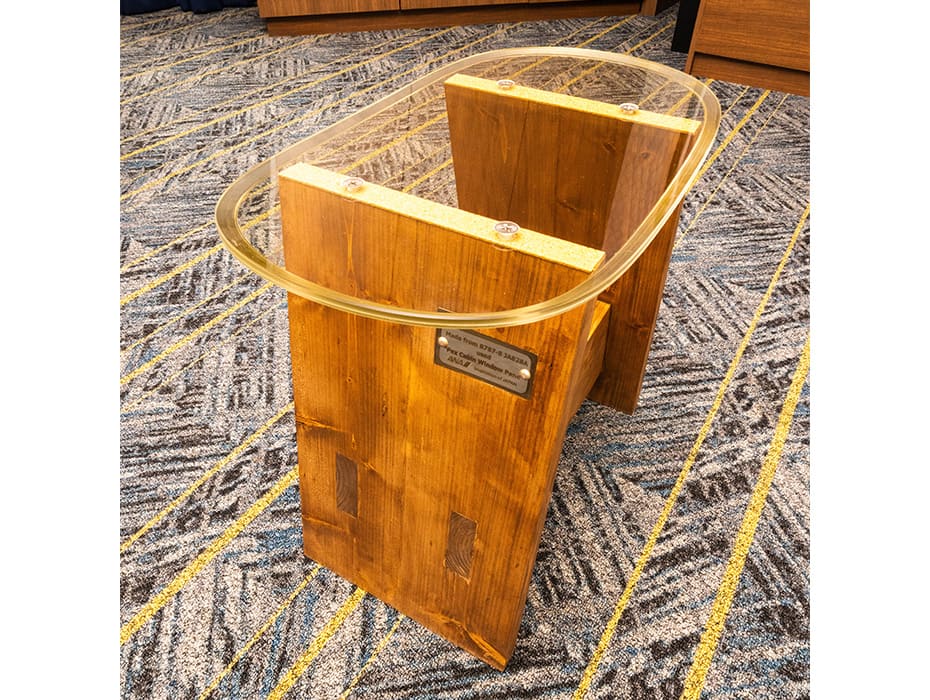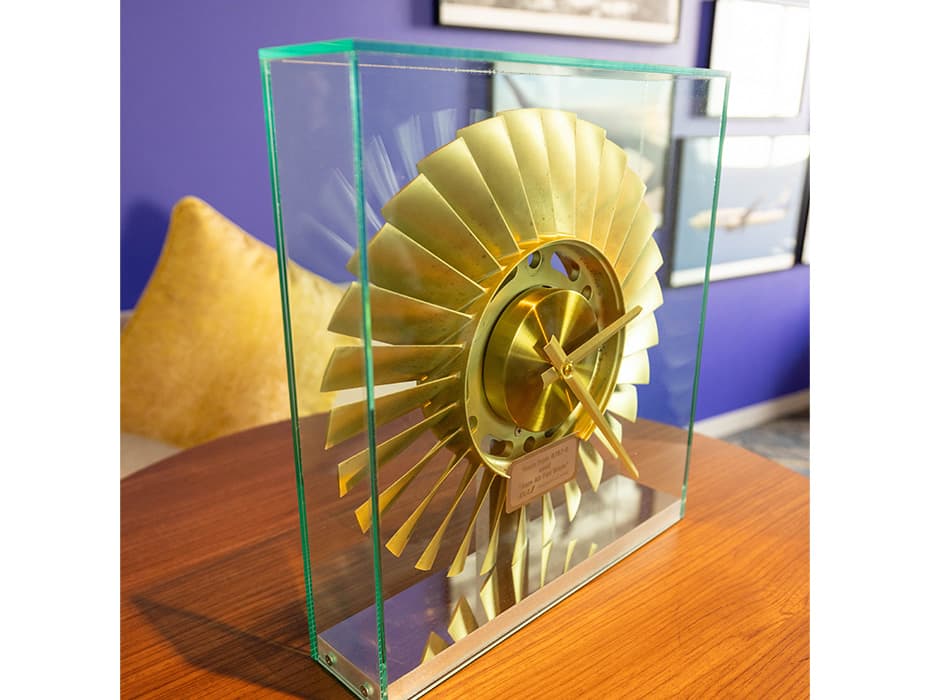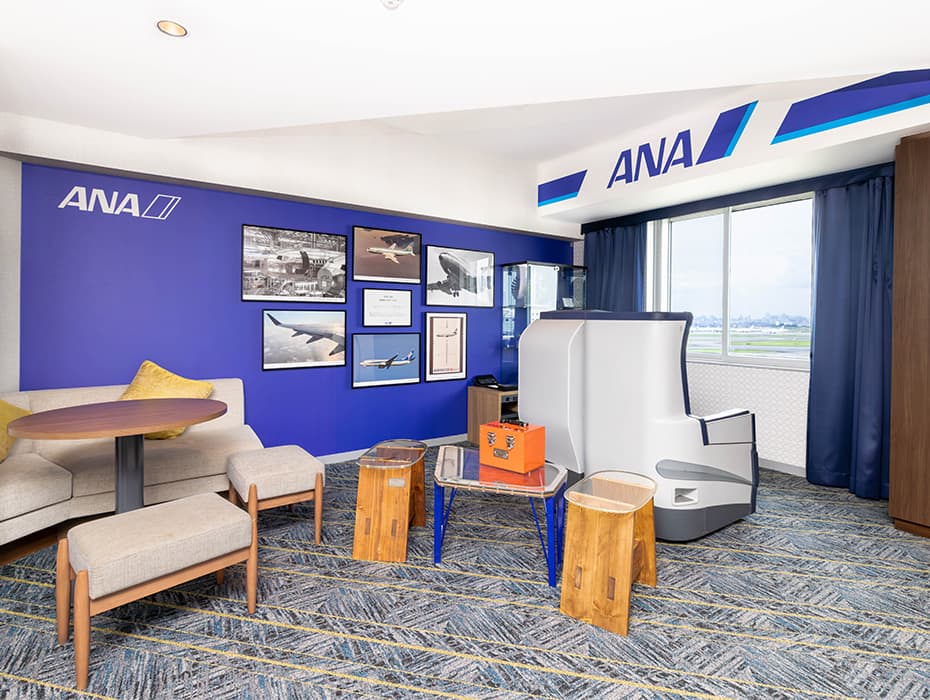2024/7/12
The ANA Group has been promoting upcycling initiatives to reduce resource waste by transforming waste products generated during the replacement of aircraft parts into new items. Upcycled items such as tables, stools, and ornaments handmade by ANA mechanics from discarded items have been adopted in the "ANA ROOM," a collaboration room between ANA and Villa Fontaine.
This ANA ROOM has been offered since April this year at Hotel Villa Fontaine Grand Haneda Airport, Japan's largest airport hotel, which is directly connected to Haneda Airport Terminal 3.
Upcycled products in the ANA ROOM
There are two ANA ROOMs, one for Boeing 737s and the other for Boeing 777s. The main difference is the pictures on the walls, but in addition, the Boeing 737 themed room has a side table made by mechanics using discarded cockpit windows from a Boeing 737.

In both rooms, stools made by mechanics from discarded Boeing 787 cabin windows and wood pallets used to load air cargo, are placed. You can also see and touch an upcycled signal kit box in the room, which were used to store emergency signal lights on board.


Two upcycled items can also be found in the showcase in the room. One of them is a clock made by a mechanic from discarded motor fans that are part of an aircraft's air conditioning system, and the other is an ornament made from discarded cabin windows from a Boeing 787 that resembles an aircraft's tail fin.


Other highlights of the ANA ROOM
In addition to upcycled items, the ANA ROOM displays a variety of aircraft parts that are not usually seen. In the showcase, numerous parts are displayed like a museum, such as the TAT sensor, a device that measures the outside air temperature during flight, and the control display unit, a device used by the pilot in the cockpit to input data.
You can also see the runways and airplanes of Haneda Airport from the window of the ANA ROOM, and we have installed business class seats on the window side so that you can enjoy such a view and relax. We hope you will feel as if you are traveling on an airplane.

Interviews

We interviewed our group employees who took part in creating this collaboration room.
How did you come up with this collaboration room?
(Mr. Matsui, ANA Akindo) ANA Akindo has been developing the ANA ROOM, a concept room for experiencing the ANA brand, airplanes, and travel, since 2021, and it has been well received, especially by ANA fans and aviation enthusiasts. The ANA ROOM is designed to provide guests with a full experience of the ANA brand and airplanes, with a variety of contents owned by ANA Group companies, such as in-flight seats and amenities, scattered throughout the rooms. However, due to the rapid return of flights after COVID-19 disaster, we were faced with the challenge of being more limited in what we could procure for the room than before. In such a situation, with the full cooperation of the ANA Engineering and Maintenance Center, we established a scheme to procure discarded aircraft parts, and this time we were able to introduce ornaments and furniture planned and created by ANA mechanics into the ANA ROOM as new contents. In addition, we were able to collect old-advertisements and in-flight seats from ANA's past with the cooperation of various departments, enabling us to develop Villa Fontaine Haneda Airport with sufficient content for a more ANA brand experience.
(Mr. Shimmura, ANA Engineering and Maintenance Center) For some time now, many people from various departments have asked if it would be possible to display parts that are no longer in use so that customers would feel closer to ANA, but we were concerned about showing people parts that are no longer in use. It was under such circumstances that we were approached by ANA Akindo's staff, who actually visited the warehouse of discarded parts, selected items, and showed us the new value of the discarded parts. As a result, the realization of the value of the discarded parts led to the decision to provide them, and this initiative was realized through direct exchange of opinions and cooperation within the ANA Group.
Where did you get the idea for the tables, stools and ornaments you designed and made?
(Mr. Oi, ANA Engineering and Maintenance Center) Since the items were to be installed in hotel rooms, we thought it would be interesting to offer items that guests could touch directly. After considering the shape characteristics and strength of each aircraft part, the mechanics in charge of the project worked through a process of trial and error to come up with ideas on what kind of item could be created that would be completely different from its original use as a part.
Is there anything you would like guests to see in the room?
(Mr. Matsui, ANA Akindo) I would like the guests to experience contents only available at Villa Fontaine Grand Haneda Airport. Since the hotel is directly connected to Terminal 3, you can enjoy a panoramic view of Haneda Airport's Runway B from the guest room windows. For the first time, we have installed air-band receivers (aviation radio receivers) in the rooms, so you can listen to the pilots and air traffic controllers as you sit in your business class seat, and depending on the weather, you can watch planes take off and land through the window. In addition, each room displays old advertising posters and the old in-flight magazines related to Boeing 737s and the Boeing 777s. Both of these aircraft are still in service, but we hope you can enjoy looking at the history of ANA since those aircrafts were introduced, which could lead you to enjoy airplanes and air travel even more.
(Mr. Oi, ANA Engineering and Maintenance Center) Each upcycled item has a laser-engraved plate with the aircraft number of the plane in which it was installed. We hope that the upcycled items will bring back memories of the many passengers who have flown in and out of Japan. A stool made from the cabin window and a vertical tail fin ornament that is a scaled-down version of the actual aircraft are on display. They are both made from Boeing 787 cabin windows and the Boeing 787 has windows that are thicker than those of other models to sufficiently withstand pressurization. We would like you to feel the thickness of those windows. The cockpit window of a Boeing 737 consists of a total of six panes, and the one upcycled into the side table this time is the rightmost window viewed from inside the cockpit. The legs of the table are painted in Triton blue, the color used on ANA aircraft, which is another particular feature of the table. Finally, motor fans, a component of air conditioning units, are anodized during production to prevent corrosion and increase surface hardness so that the aluminum material does not deteriorate due to corrosive elements in the air. When upcycling this motor fan into a clock, we kept the beautiful yellow-green color of the anodized material and this is another interesting point to look at.
We will continue our efforts to reduce resource waste through upcycling.




